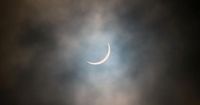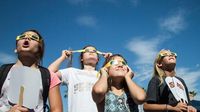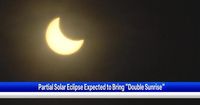Almost two weeks ago, it was the moon that dazzled spectators. This week, it will be the sun. On Saturday, March 29, 2025, the northeastern United States and Canada will witness a partial solar eclipse in the early hours of the day, according to Space.com, presenting a spectacle that will look as if the moon took a bite out of the sun.
Even though it's only a partial eclipse and will be a lot different from the sensational total solar eclipse of April 2024 that dazzled millions of Americans, you will still need eye protection to view it at all times. Here's what to know about the solar eclipse and why you will need glasses to see it.
The partial solar eclipse will begin early Saturday morning, around 4:50 a.m. EDT and end just before 8:43 a.m., according to the website Time and Date. The eclipse will be visible and peak at different times depending on the location in the United States.
Those planning to watch the solar eclipse should plan to wear safety glasses or take steps to otherwise protect their eyes from the sun's harmful rays. Unlike last year's total solar eclipse, during which there were a few brief moments during totality when the sun was shielded and people could safely remove eyewear to take in the sight, during a partial solar eclipse, there is no safe time for sky gazers to view the spectacle with the naked eye. This is because the sun will never be completely covered this time around.
It's never safe to look at the sun with the naked eye, and a partial solar eclipse can expose your eyes to possibly harmful ultraviolet (UV) rays. Without proper eye protection, you can suffer "eclipse blindness" within seconds of staring at the sun, which can later lead to a serious injury in which the eye’s retina is damaged by solar radiation, according to the American Optometric Association.
NASA strictly warns against looking at the sun through a camera lens, telescope, binoculars, or any other optical device even while wearing eclipse glasses or using a handheld solar viewer because "the concentrated solar rays will burn through the filter and cause serious eye injury."
The American Astronomical Society maintains a curated list of approved vendors of solar eclipse glasses, which are the most common form of protection used for viewing solar eclipses. These glasses are not your ordinary sunglasses – they must be thousands of times darker to comply with international safety standards. The glasses should also have the "ISO" (International Organization for Standardization) icon with the reference number 12312-2.
Solar eclipse glasses are available to purchase both in-store and online at retailers such as American Paper Optics, the nation's largest supplier of eclipse glasses, Walmart, Amazon, and Warby Parker. It is also worth checking your local libraries, astronomical observatories, schools, and other public agencies to see if they are giving away eclipse glasses for free. Just be warned: plenty of fakes and imitators exist, so it is always best to get your glasses from a reliable vendor.
A solar eclipse is what occurs when the moon, as it orbits the Earth, comes in between the sun and the Earth. That differs from what happened earlier in March during the lunar eclipse, when the Earth came between the sun and moon to block sunlight from reaching our celestial neighbor. During last year's total solar eclipse, spectators in the path of totality witnessed a stunning sight as the Earth, sun, and moon perfectly aligned for a few minutes. The process not only ushered in uncharacteristic darkness but unveiled the outermost layer of the sun's atmosphere, the corona.
That isn't what will happen during this week's partial solar eclipse. As the name suggests, this time around the moon will only partly cover the sun, giving it a crescent shape, according to NASA. Instead of the signature circular ring, a partial solar eclipse is also what some sky gazers outside the path of totality – the area covered by the moon's inner shadow – were able to see last April.
As excitement builds for this celestial event, experts remind viewers that safety is paramount. With the right precautions, sky gazers can enjoy this natural wonder without risking their eyesight. So grab those eclipse glasses and prepare for a unique experience!




